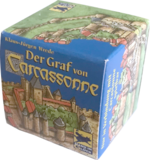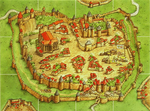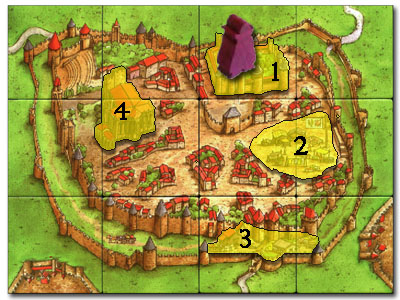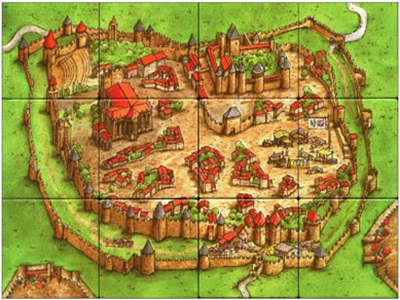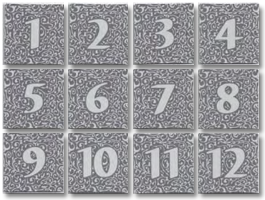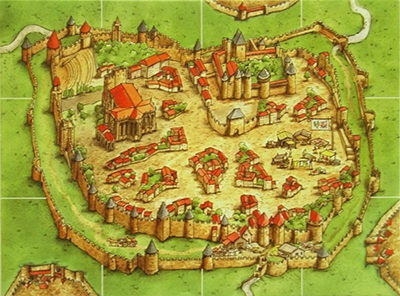Contele din Carcassonne (prima ediție)
Informații generale și comentarii
Extensia Contele din Carcassonne a fost lansată original de Hans im Glück în 2004.
În 2007 a fost lansată ca parte din Contele, regele și vasalii.
În 2015 a fost vândut în magazinul web CundCo ca un singur cartonaș 4x3. Totuși, această versiune prezintă 1 segment adițional de oraș în partea de sus neinclus în designul original.
Conținut
- 12 cartonașe de oraș noi
- 1 conte
Reguli
Pregătire
La începutul jocului, cele douăsprezece cartonașe de oraș sunt plasate pe masă astfel încât să formeze un singur oraș. Acest oraș[1] - Carcassonne însuși - servește drept punctul de pornire pentru joc.[2][3][4] Prin urmare, cartonașul normal de pornire nu este folosit.[5][6]
Există patru cartiere în oraș:
- castelul[7]
- piața
- fierăria
- catedrala
Pionul conte de lemn ar trebui plasat în cartierul castel din Carcassonne, iar apoi jocul ar trebui să înceapă ca în mod obișnuit.
Atașarea unui cartonaș
Nu există niciun cartonaș de teren asociat cu această extensie specifică. Trage și plasează cartonașe de teren din jocul de bază și alte extensii care sunt folosite în concordanță cu regulile normale. Cartonașele pot fi plasate contra blocului de pornire al orașului Carcassonne pentru a construi peisajul ca în mod normal.
Plasarea unui supus
Dacă plasezi un cartonaș pentru a extinde un teritoriu de peisaj de pe orașul Carcassonne (drum, oraș sau câmp), ai posibilitatea de a plasa un supus pe el în concordanță cu regulile normale.
Evaluare
Dacă plasezi un cartonaș care finalizează un teritoriu de pe orașul Carcassonne (drum, oraș), este evaluat în concordanță cu regulile normale.
Totuși, atunci când se utilizează extensia Contele din Carcassonne, au loc acțiuni adiționale dacă, prin plasarea unui cartonaș, este evaluat un teritoriu oriunde pe suprafața de joc de alt jucător, sau jucători, dar nu de jucătorul care plasează cartonașul care o declanșează. Asta este descris mai jos.
Plasarea supușilor în și din Carcassonne
Whenever a player places a tile that causes at least one player to score points, [8] [9] but the player placing the tile does not, this player may deploy one follower from his or her supply to a city quarter of his or her choice. [10] [11] [12] [13] If several features are completed, the player must not score points in any of them in order to take advantage of this opportunity.
A player may only deploy one follower to Carcassonne each turn. [14] This placement is in addition to any follower he may place as part of his normal turn, but he may only place one follower in Carcassonne per tile placed, regardless of how many scoring opportunities this placement causes. [15]
However, if a player has a double turn—because of the builder—a follower may be deployed to Carcassonne in both parts of the turn. [16]
Big followers may also be deployed to Carcassonne; as usual, they count as two followers as far as the calculation of the majority in a feature is concerned. [17] If using Abbey and Mayor, the mayor may also be deployed to the castle quarter, and the wagon to the castle, blacksmith, or cathedral quarters. [18]
If a feature is completed [19] [20] during the subsequent course of play, then before scoring takes place, [21] all players may redeploy their followers from the appropriate city quarter to the feature being scored (with the exception of those followers in the same city quarter as the Count). In this way, followers may thus be deployed to already occupied features.
Supușii pot fi replasați în concordanță cu aceste reguli:
- from the castle quarter (1), a follower may be moved to a city [22]
- from the blacksmith's quarter (3), a follower may be moved to a road
- from the cathedral quarter (4) a follower may be moved to a cloister [23] [24] [25]
- from the market quarter (2), a follower may be moved to a farm [26]
Followers in the market quarter may only be redeployed at the end of the game. [27] [28]
Cum funcționează asta în practică?
The player to the left of the one who placed the tile causing the scoring begins, followed in turn by the other players, with the redeployment round moving once around the table. [29] Thus, the player who placed the tile may redeploy his or her followers last. Each player may choose to redeploy all, any, or none of his or her followers from the appropriate city quarter to the feature being scored. Scoring then continues as usual. [30]
Any follower which is not redeployed remains in Carcassonne. Followers in Carcassonne may only be redeployed in the manner described above. They may not be returned to the player in any other way (such as returning to the players’ play areas). The dragon may not move onto any of the 12 tiles of the City, and so cannot “eat” the Count, nor any of the followers deployed there. [31] [32] [33] [34]
| The Count of Carcassonne |
Contele
When a player deploys a follower to Carcassonne, he or she may also move the Count to one of the City quarters. From the quarter in which the Count is currently residing, no followers may be redeployed. [35] For example, if a city is being scored, and the Count is residing in the castle, no one may redeploy a follower from the castle to a city.
Supușii din acest cartier rămân în anturajul Contelui—și prin urmare sunt blocați până ce Contele este mutat în alt cartier. Contele ar trebui întotdeauna să stea clar într-unul dintre cartiere și niciodată nu părăsește orașul Carcassonne.
Variante oficiale
Chiar și aristocrația este supusă anumitor reguli și nu poate face pur și simplu ceea ce își dorește. Următoarele variante iau în considerare acest lucru și constrâng libertatea contelui. Utilizarea acestor variante îi va acorda miniextensiei chiar și mai multe posibilități tactice. În ambele variante, contele nu mai poate fi mutat liber, ci în schimb:
- de fiecare dată când este plasat un nou supus în orașul Carcassonne, contele este mutat în sensul acelor de ceasornic în următorul cartier al orașului, sau
- contele este mutat în oricare cartierul al orașului în care este plasat noul supus.
Reguli ale casei
Plasează râul mai întâi, apoi potrivește orașul Carcassonne lângă el astfel încât cele mai multe cartonașe să fie atinse. Cel mai probabil asta va părea să facă râul să curgă în jurul orașului.
Ansamblul cartonașelor
Versiunea din 2004/2008
Versoul cartonașelor:
Versiunea din 2015
Note de subsol
Pentru licențierea și semnificația pictogramelor te rugăm să vizitezi Pagina pictogramelor.
- ↑
 Orașul Carcassonne se socotește atunci când se evaluează ferme la sfârșitul jocului și de asemenea se socotește când se încasează puncte pentru cartonașul regelui. (11/2013)
Orașul Carcassonne se socotește atunci când se evaluează ferme la sfârșitul jocului și de asemenea se socotește când se încasează puncte pentru cartonașul regelui. (11/2013)
- ↑
 Pot fi plasați supuși pe teritorii de pe cartonașe ale orașului Carcassonne aflate în afara orașului Carcassonne, de exemplu prin utilizarea unui coridor fermecat sau unui aparat de zbor. (1/2013)
Pot fi plasați supuși pe teritorii de pe cartonașe ale orașului Carcassonne aflate în afara orașului Carcassonne, de exemplu prin utilizarea unui coridor fermecat sau unui aparat de zbor. (1/2013)
- ↑
 Dragonul poate zbura în jurul și în afara orașului Carcassonne, tratând zonele cu teren ca cartonașe normale și mâncând orice supus de pe acele cartonașe. Supușii și contele din orașul Carcassonne nu sunt afectați. Asta reprezintă o schimbare notabil de la FAQ-uri anterioare. (10/2012)
Dragonul poate zbura în jurul și în afara orașului Carcassonne, tratând zonele cu teren ca cartonașe normale și mâncând orice supus de pe acele cartonașe. Supușii și contele din orașul Carcassonne nu sunt afectați. Asta reprezintă o schimbare notabil de la FAQ-uri anterioare. (10/2012)
- ↑
 Având în vedere noile interpretări privitoare la plasarea dragonului și a supușilor pe teritorii din afara orașului Carcassonne, pare că și ciuma ar trebui permisă pe porțiunea de afară a acestor cartonașe. Totuși, asta este neoficial. (1/2013)
Având în vedere noile interpretări privitoare la plasarea dragonului și a supușilor pe teritorii din afara orașului Carcassonne, pare că și ciuma ar trebui permisă pe porțiunea de afară a acestor cartonașe. Totuși, asta este neoficial. (1/2013)
- ↑
 Ultimele reguli pentru Râul II afirmă că „dacă decizi să utilizezi Contele din Carcassonne și Râul II drept cartonașe de pornire pentru o partidă, este posibil ca cineva să nu fie în stare să folosească toate cartonașele de râu dacă acestea sunt plasate prea aproape de orașul Carcassonne. Cartonașele de râu care nu pot fi plasate ar trebui eliminate din joc, în concordanță cu regulile de bază. Chiar dacă râul nu poate fi plasat în întregimea sa, jocul ar trebui să continue ca în modul obișnuit”. Vezi comentariile de la Râul II pentru mai multe informații.
Ultimele reguli pentru Râul II afirmă că „dacă decizi să utilizezi Contele din Carcassonne și Râul II drept cartonașe de pornire pentru o partidă, este posibil ca cineva să nu fie în stare să folosească toate cartonașele de râu dacă acestea sunt plasate prea aproape de orașul Carcassonne. Cartonașele de râu care nu pot fi plasate ar trebui eliminate din joc, în concordanță cu regulile de bază. Chiar dacă râul nu poate fi plasat în întregimea sa, jocul ar trebui să continue ca în modul obișnuit”. Vezi comentariile de la Râul II pentru mai multe informații.
- ↑
 Regulile originale au adăugat următoarea clarificare-propoziție: „Dacă râul este în uz, atunci cartonașul cu izvor ar trebui plasat lângă și în așa fel încât râul pleacă dinspre oraș”. Compară asta cu paragraful introductiv al regulilor pentru Contele, regele și vasalii: „Nu este recomandat să se combine Contele din Carcassonne cu Râul II, căci pot apărea situații în care este imposibil să se plaseze cartonașele în mod corespunzător”. Cu alte cuvinte, poziția oficială s-a schimbat de-a lungul anilor.
Regulile originale au adăugat următoarea clarificare-propoziție: „Dacă râul este în uz, atunci cartonașul cu izvor ar trebui plasat lângă și în așa fel încât râul pleacă dinspre oraș”. Compară asta cu paragraful introductiv al regulilor pentru Contele, regele și vasalii: „Nu este recomandat să se combine Contele din Carcassonne cu Râul II, căci pot apărea situații în care este imposibil să se plaseze cartonașele în mod corespunzător”. Cu alte cuvinte, poziția oficială s-a schimbat de-a lungul anilor.
- ↑
 Lineart a tradus acest concept ca „castel”, dar o traducere oarecum fidelă ar putea fi în schimb și „palat”. Totuși, nici „castel”, nici „palat” nu reprezintă o traducere fidelă pentru „schloss”.
Lineart a tradus acest concept ca „castel”, dar o traducere oarecum fidelă ar putea fi în schimb și „palat”. Totuși, nici „castel”, nici „palat” nu reprezintă o traducere fidelă pentru „schloss”.
- ↑
 The original version of the rules specifically mention completion of a road, city, or cloister as necessary to trigger the placement of a follower in Carcassonne. However, the RGG version of the rules and the Big Box 2 rules change the rule to that given here.
The original version of the rules specifically mention completion of a road, city, or cloister as necessary to trigger the placement of a follower in Carcassonne. However, the RGG version of the rules and the Big Box 2 rules change the rule to that given here.
- ↑
 It is clear from the wording that only scoring caused by placement of a tile can trigger placement of a follower in Carcassonne. Thus, scoring from non-landscape-tile related events (such as from dispatches (The Messages or paying a ransom for the Tower (The Tower)) would not trigger follower placement. Interestingly, though, another FAQ answer (below and on the Abbey & Mayor page) indicates that placement of a barn does trigger the ability to place a follower in Carcassonne.
It is clear from the wording that only scoring caused by placement of a tile can trigger placement of a follower in Carcassonne. Thus, scoring from non-landscape-tile related events (such as from dispatches (The Messages or paying a ransom for the Tower (The Tower)) would not trigger follower placement. Interestingly, though, another FAQ answer (below and on the Abbey & Mayor page) indicates that placement of a barn does trigger the ability to place a follower in Carcassonne.
- ↑
 The mayor, the wagon, and the abbot can be placed in the appropriate quarter of Carcassonne. The barn cannot be placed in the city of Carcassonne. (updated 3/2015)
The mayor, the wagon, and the abbot can be placed in the appropriate quarter of Carcassonne. The barn cannot be placed in the city of Carcassonne. (updated 3/2015)
- ↑
 Question: If I place a barn on a farm on which another player has farmers, causing him/her to score while I score nothing, can I move a follower to Carcassonne? (While there is no immediate score to me now, the barn is certain to score at the end of the game). Answer: Yes, that’s allowed. Only immediately scored points matter. A similar question arises with regard to trade goods, which may lead to points at the end of the game.
Question: If I place a barn on a farm on which another player has farmers, causing him/her to score while I score nothing, can I move a follower to Carcassonne? (While there is no immediate score to me now, the barn is certain to score at the end of the game). Answer: Yes, that’s allowed. Only immediately scored points matter. A similar question arises with regard to trade goods, which may lead to points at the end of the game.
- ↑
 Question: Say I have a heretic engaged in a challenge with a monk, and I place the tile which completes the monk's cloister, so that the monk scores 9 points and I score 0. Can I still move a follower to Carcassonne in this case? Answer: Yes, triggered scoring, received no points: conditions fulfilled.
Question: Say I have a heretic engaged in a challenge with a monk, and I place the tile which completes the monk's cloister, so that the monk scores 9 points and I score 0. Can I still move a follower to Carcassonne in this case? Answer: Yes, triggered scoring, received no points: conditions fulfilled.
- ↑
 A follower cannot be deployed to Carcassonne via a magic portal. The magic portal only allows followers to be deployed to tiles that can be legally occupied according to the usual rules, as if the player had just placed the tile in question. Carcassonne is occupied according to different rules.
A follower cannot be deployed to Carcassonne via a magic portal. The magic portal only allows followers to be deployed to tiles that can be legally occupied according to the usual rules, as if the player had just placed the tile in question. Carcassonne is occupied according to different rules.
- ↑
 A player who completes a road, city, or cloister, but without profit, cannot deploy a follower to Carcassonne and redeploy another before the area is scored. Scoring takes place first, and then, should the occasion arise, a follower may be deployed to Carcassonne. If a player uses a follower which is already in Carcassonne, then he or she profits from the scoring, and as such may not move another follower to Carcassonne.
A player who completes a road, city, or cloister, but without profit, cannot deploy a follower to Carcassonne and redeploy another before the area is scored. Scoring takes place first, and then, should the occasion arise, a follower may be deployed to Carcassonne. If a player uses a follower which is already in Carcassonne, then he or she profits from the scoring, and as such may not move another follower to Carcassonne.
- ↑
 This sentence is an addition to the rules in the RGG edition of Big Box 2.
This sentence is an addition to the rules in the RGG edition of Big Box 2.
- ↑
 This sentence originally occurs later in the rules, in a section dealing with how to combine The Count of Carcassonne with other expansions. Also, the version of the rules in Count, King and Consorts clarifies that a follower may be deployed to Carcassonne in both “parts” of a double turn, rather than in both “turns” — because a double turn is considered to be a single turn, rather than two separate turns.
This sentence originally occurs later in the rules, in a section dealing with how to combine The Count of Carcassonne with other expansions. Also, the version of the rules in Count, King and Consorts clarifies that a follower may be deployed to Carcassonne in both “parts” of a double turn, rather than in both “turns” — because a double turn is considered to be a single turn, rather than two separate turns.
- ↑
 This sentence also appeared in the section on combining this expansion with others.
This sentence also appeared in the section on combining this expansion with others.
- ↑
 This last sentence is taken from HiG’s Big Box 2 rules, where it occurs a little later in the text. It also occurs in the RGG edition.
This last sentence is taken from HiG’s Big Box 2 rules, where it occurs a little later in the text. It also occurs in the RGG edition.
 There is also a sentence which says that, “if they are involved in a scoring, he counts as two followers as usual.” Since a mayor is valued according to the number of pennants in a city, and the wagon counts as a single follower, I can only conclude that this sentence is the result of an unfortunate copy-and-paste from the rules about big followers. It should probably read, “if they are involved in scoring a feature, they count towards the majority as usual.” However, the RGG edition translates it as, “if they are used when scoring, each counts as two followers.”
There is also a sentence which says that, “if they are involved in a scoring, he counts as two followers as usual.” Since a mayor is valued according to the number of pennants in a city, and the wagon counts as a single follower, I can only conclude that this sentence is the result of an unfortunate copy-and-paste from the rules about big followers. It should probably read, “if they are involved in scoring a feature, they count towards the majority as usual.” However, the RGG edition translates it as, “if they are used when scoring, each counts as two followers.”
- ↑
 Followers in Carcassonne can be redeployed to empty roads, cities, cloisters, or farms. When an empty road, city, or cloister is completed, followers in the appropriate quarter of the city [followers in the castle can only be deployed to cities, and so on] may be redeployed and then scored immediately. In general, unoccupied cities, roads, cloisters do not earn very many points, and so this option in mostly useful for returning followers from Carcassonne to a player's supply.
Followers in Carcassonne can be redeployed to empty roads, cities, cloisters, or farms. When an empty road, city, or cloister is completed, followers in the appropriate quarter of the city [followers in the castle can only be deployed to cities, and so on] may be redeployed and then scored immediately. In general, unoccupied cities, roads, cloisters do not earn very many points, and so this option in mostly useful for returning followers from Carcassonne to a player's supply.
- ↑
 The RGG rules state “when a [feature] is scored” rather than completed, potentially providing confusion when comparing the different rule sets (e.g. for unoccupied structures, where nobody gets points). However, as castles (Bridges, Castles and Bazaars) prove, all structures do score, even if there is no follower present to get those points. Thus, no contradiction.
The RGG rules state “when a [feature] is scored” rather than completed, potentially providing confusion when comparing the different rule sets (e.g. for unoccupied structures, where nobody gets points). However, as castles (Bridges, Castles and Bazaars) prove, all structures do score, even if there is no follower present to get those points. Thus, no contradiction.
- ↑
 This is a minor change from the original rules, which read, “before the calculation of the majority.”
This is a minor change from the original rules, which read, “before the calculation of the majority.”
- ↑
 Followers from the City of Carcassonne (the castle quarter) cannot move to a castle (from (Bridges, Castles and Bazaars), as a castle is not a city, but is instead a new type of feature.
Followers from the City of Carcassonne (the castle quarter) cannot move to a castle (from (Bridges, Castles and Bazaars), as a castle is not a city, but is instead a new type of feature.
- ↑
 Question: Until now it was impossible to deploy a second monk to a cloister... Answer: That is exactly the point. There was no rule that said only one monk could occupy a cloister. It was simply not possible because of the rules for placing tiles. This is the first opportunity for stealing a cloister away from a player. And deploying the big follower to a cloister may now be worthwhile as well.
Question: Until now it was impossible to deploy a second monk to a cloister... Answer: That is exactly the point. There was no rule that said only one monk could occupy a cloister. It was simply not possible because of the rules for placing tiles. This is the first opportunity for stealing a cloister away from a player. And deploying the big follower to a cloister may now be worthwhile as well.
- ↑
 An abbey has all of the characteristics of a cloister, so a follower can be moved from the cathedral quarter to an abbey. A follower also can be moved from the cathedral quarter to a cult place/shrine or to a German Monastery functioning as a cloister. If so, that follower must also be declared to be a monk (not an abbot), because the feature was only finished for scoring as a cloister. A follower cannot be moved from the cathedral quarter to a German Monastery placed as an abbot (that is, one with the special German Monastery function that will be scored only at the end of the game). (6 & 10/2014)
An abbey has all of the characteristics of a cloister, so a follower can be moved from the cathedral quarter to an abbey. A follower also can be moved from the cathedral quarter to a cult place/shrine or to a German Monastery functioning as a cloister. If so, that follower must also be declared to be a monk (not an abbot), because the feature was only finished for scoring as a cloister. A follower cannot be moved from the cathedral quarter to a German Monastery placed as an abbot (that is, one with the special German Monastery function that will be scored only at the end of the game). (6 & 10/2014)
- ↑
 A German monastery has to be unoccupied or occupied by one monk at least (no matter the presence of other followers placed as abbots) to be considered completed when surrounded by tiles. A monastery cannot be completed if occupied only by followers placed as abbots.
A German monastery has to be unoccupied or occupied by one monk at least (no matter the presence of other followers placed as abbots) to be considered completed when surrounded by tiles. A monastery cannot be completed if occupied only by followers placed as abbots.
- ↑
 A follower can be moved from Carcassonne to a farm with a barn. The farmer will be scored immediately, and so scores only 1 point per city and is (importantly) not on the farm during the final scoring proper. [Obviously, placement of a follower in this manner still requires a scoring trigger as per the fundamental rules – this could be at the end of the game or with joining of a barnless farm to one with a barn – Chris O.]
A follower can be moved from Carcassonne to a farm with a barn. The farmer will be scored immediately, and so scores only 1 point per city and is (importantly) not on the farm during the final scoring proper. [Obviously, placement of a follower in this manner still requires a scoring trigger as per the fundamental rules – this could be at the end of the game or with joining of a barnless farm to one with a barn – Chris O.]
- ↑
 This is no longer entirely true. Placing of a barn, and the subsequent scoring of the farm, does count as an opportunity to remove a follower from Carcassonne. Now that farms can be scored at times other than at the end of the game, followers from the market can be moved to farms earlier in the game. That occurs immediately after the placement of the barn, and before the farmers are scored. [Joining of a farm containing a follower to a farm with a barn would logically be another opportunity – Chris O.]
This is no longer entirely true. Placing of a barn, and the subsequent scoring of the farm, does count as an opportunity to remove a follower from Carcassonne. Now that farms can be scored at times other than at the end of the game, followers from the market can be moved to farms earlier in the game. That occurs immediately after the placement of the barn, and before the farmers are scored. [Joining of a farm containing a follower to a farm with a barn would logically be another opportunity – Chris O.]
- ↑
 Question: How does follower placement during the final scoring work? Answer: In principle very similarly to the way it works during the game. The 'trigger' for the final scoring is the player who placed the last tile and so ended the game. Beginning with the player on the left of the 'trigger' player, each player redeploys one of his or her followers from Carcassonne to an appropriate feature [followers in castle can only be deployed to cities, and so on] on the board. Followers can also be redeployed to incomplete roads, cities, cloisters, or farms, since these will also be scored at the end of the game. This process continues until no player can redeploy any more players from Carcassonne. The Count still blocks the city quarter in which he is resident. Normally the player with the most followers in Carcassonne will be the one to redeploy the last figure.
Question: How does follower placement during the final scoring work? Answer: In principle very similarly to the way it works during the game. The 'trigger' for the final scoring is the player who placed the last tile and so ended the game. Beginning with the player on the left of the 'trigger' player, each player redeploys one of his or her followers from Carcassonne to an appropriate feature [followers in castle can only be deployed to cities, and so on] on the board. Followers can also be redeployed to incomplete roads, cities, cloisters, or farms, since these will also be scored at the end of the game. This process continues until no player can redeploy any more players from Carcassonne. The Count still blocks the city quarter in which he is resident. Normally the player with the most followers in Carcassonne will be the one to redeploy the last figure.
- ↑
 The statement specifying that there is only one round of redeployment is a specific clarification in the RGG rules.
The statement specifying that there is only one round of redeployment is a specific clarification in the RGG rules.
- ↑
 Followers in Carcassonne are not scored. However, the followers can influence the usual scoring, as players can redeploy their figures to any city, road, cloister, or farm that is currently being scored.
Followers in Carcassonne are not scored. However, the followers can influence the usual scoring, as players can redeploy their figures to any city, road, cloister, or farm that is currently being scored.
- ↑
 This sentence occurs later in the text of HiG’s Big Box 2 rules. It confirms earlier FAQs, as shown below. It is also in the RGG edition.
This sentence occurs later in the text of HiG’s Big Box 2 rules. It confirms earlier FAQs, as shown below. It is also in the RGG edition.
- ↑
 The dragon can fly around the outside of Carcassonne, treating the landscape areas as normal tiles and eating any figures on those tiles. Followers (and the Count) inside Carcassonne are unaffected. This represents a notable change from previous FAQs. (10/2012)
The dragon can fly around the outside of Carcassonne, treating the landscape areas as normal tiles and eating any figures on those tiles. Followers (and the Count) inside Carcassonne are unaffected. This represents a notable change from previous FAQs. (10/2012)
- ↑
 Given new interpretations regarding placement of the dragon and followers on features outside the City of Carcassonne, it seems that the plague should also be allowed on the outside portion of these tiles. However, this is unofficial. (1/2013)
Given new interpretations regarding placement of the dragon and followers on features outside the City of Carcassonne, it seems that the plague should also be allowed on the outside portion of these tiles. However, this is unofficial. (1/2013)
- ↑
 Followers can be deployed on features on City of Carcassonne tiles outside the City of Carcassonne itself, for example through use of a magic portal or as a flier. (1/2013)
Followers can be deployed on features on City of Carcassonne tiles outside the City of Carcassonne itself, for example through use of a magic portal or as a flier. (1/2013)
- ↑
 The RGG Big Box 2 edition of the rules states “No player may move a follower to or from the quarter where the count stands.” (Emphasis added.) This addition is not seen in any other version of the rules.
The RGG Big Box 2 edition of the rules states “No player may move a follower to or from the quarter where the count stands.” (Emphasis added.) This addition is not seen in any other version of the rules.
